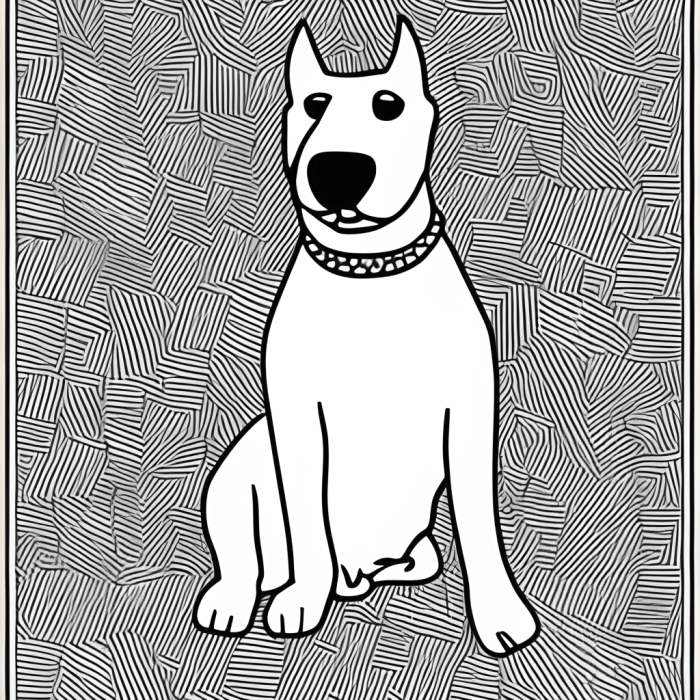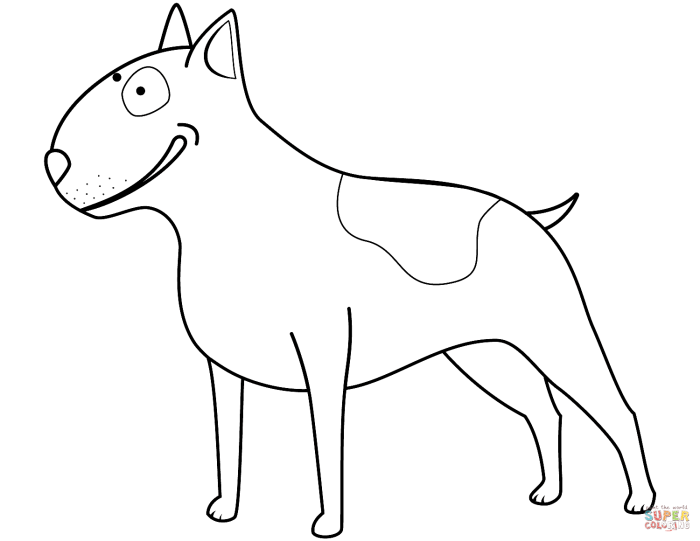Bull Terrier Breed Characteristics for Coloring Pages

Bull terrier coloring book – This section details the unique characteristics of Bull Terriers to help you create vibrant and accurate coloring pages. Understanding their distinct features will bring your artwork to life, capturing the breed’s spirited personality and striking appearance. We’ll explore their body shape, head structure, coat variations, and common poses, providing a comprehensive guide for your creative endeavors.
Unleash your creativity with a bull terrier coloring book; the playful patterns and charming features offer a delightful escape. For a deeper sense of calm, consider pairing it with the break free from anxiety coloring book , a fantastic resource for stress relief. Then, return to your bull terrier coloring book, feeling refreshed and ready to continue your artistic journey, finding joy in every stroke.
Bull Terrier Physical Features
The Bull Terrier’s distinctive features are what make them instantly recognizable. Their egg-shaped head is perhaps their most striking characteristic, smoothly curving from the forehead to the muzzle, with a pronounced stop (the slight indentation between the forehead and the nose). Their ears, typically rose-shaped or cropped, add to their unique profile. The coat is short, smooth, and dense, giving it a sleek appearance.
Coloring this smooth texture should be relatively straightforward, allowing for bold color choices and sharp lines. Consider using different shading techniques to capture the subtle highlights and shadows on their muscular bodies.
Bull Terrier Poses for Coloring Pages
Five coloring page designs are presented below, each capturing a different aspect of the Bull Terrier’s personality. Accurate representation of their musculature and posture is key to bringing these designs to life.
Playful Pose: Depict a Bull Terrier playfully pouncing, perhaps mid-leap with paws extended and mouth slightly open in a happy grin. The body should be slightly arched, conveying energy and excitement. Focus on the dynamic movement of the muscles and the expression in the eyes.
Sleeping Pose: A Bull Terrier curled up asleep, paws tucked under its body. This pose emphasizes the soft curves of their body. Pay attention to the relaxed posture and the gentle expression on their face. Use softer shading to convey a sense of calm and rest.
Alert Pose: An alert Bull Terrier standing rigidly, ears pricked, eyes focused intently on something in the distance. This pose highlights their muscular build and alert posture. Emphasize the tension in their muscles and the intensity in their gaze.
Running Pose: A Bull Terrier in full stride, legs extended, body stretched out, conveying speed and agility. Pay close attention to the movement of the legs and the powerful muscles engaged in running. Use dynamic lines to capture the sense of motion.
Sitting Pose: A Bull Terrier sitting calmly, ears relaxed, tail possibly wagging gently. This pose showcases the breed’s balanced and sturdy build. Focus on capturing the graceful yet powerful posture.
Bull Terrier Markings and Coat Colors
Bull Terriers exhibit a variety of coat colors and markings, adding to their visual appeal. These variations offer exciting opportunities for creative coloring page designs.
White: Solid white Bull Terriers are common. When coloring a white Bull Terrier, consider adding subtle shading to create depth and avoid a flat appearance. Slight variations in tone can represent shadows and highlights.
Brindle: Brindle Bull Terriers have a coat with streaks or stripes of different colors, often brown, black, or fawn, against a lighter background. Experiment with different shades and intensities of these colors to capture the complexity of the brindle pattern.
Tri-color: Tri-color Bull Terriers typically exhibit three colors in their coat, often white, black, and tan or fawn. Careful planning of color placement is crucial to achieving a realistic and balanced representation of this complex pattern. Pay attention to the distribution of each color.
Illustrations and Descriptive Details for Coloring Pages
Creating captivating coloring pages requires detailed descriptions that bring the Bull Terrier to life. The following sections provide specific guidance on illustrating the breed’s unique features, both in close-up and full-body views, and setting the scene with appropriate backgrounds.
Bull Terrier Facial Features: Close-Up, Bull terrier coloring book
A close-up coloring page should showcase the Bull Terrier’s distinctive facial features. The eyes should be depicted as small, dark, and almond-shaped, set relatively far apart. The nose is black, broad, and slightly upturned, adding to the breed’s characteristically quirky expression. The mouth should be shown with a strong jawline and a slight underbite, which is typical for the breed.
Consider adding details like wrinkles around the nose and eyes, reflecting the breed’s expressive face. The overall impression should be one of alertness and intelligence, even in a static coloring page image. Think about highlighting the subtle variations in shading around the muzzle and eyes to add depth and realism.
Bull Terrier Body Structure and Posture: Full-Body
A full-body coloring page requires attention to the Bull Terrier’s muscular build and athletic posture. The legs should be depicted as strong and straight, with well-defined muscles visible, particularly in the thighs and shoulders. The chest should be deep and broad, contributing to the breed’s powerful appearance. The tail is short and thick, often carried low, adding to the overall sturdy stance.
The coloring page should convey a sense of balance and strength. Depict the smooth, short coat, highlighting how it fits snugly against the muscular frame. Pay attention to the subtle curves of the body, conveying the power and agility of the breed.
Park Background for Bull Terrier Coloring Page
The background for a park scene should complement the Bull Terrier’s vibrant personality. Include lush green grass, rendered with varying shades to create texture and depth. A few strategically placed trees should provide shade and visual interest. The trees could be deciduous, with full, leafy canopies, or perhaps some evergreens for added contrast. Consider adding smaller details, such as wildflowers or a winding path, to enrich the scene and create a sense of a lively, natural environment.
Perhaps a bird in flight, or a butterfly flitting amongst the flowers, could add a touch of whimsical charm. The overall effect should be one of peaceful coexistence between the dog and its surroundings, enhancing the enjoyment of the coloring activity.
Age Appropriateness and Complexity Levels

Creating engaging coloring pages for Bull Terriers requires careful consideration of the target audience’s age and developmental stage. Different age groups possess varying levels of fine motor skills, attention spans, and cognitive abilities, influencing the complexity and design of the coloring pages. Therefore, a differentiated approach is crucial to ensure an enjoyable and developmentally appropriate experience for all.
Simple Coloring Page for Young Children (Ages 3-5)
This coloring page features a simplified Bull Terrier design, emphasizing large, easily identifiable shapes. The dog’s body is a large oval, the head a smaller circle, and the legs are simple, chunky rectangles. The ears are large triangles, and the tail a short, stubby line. Details like wrinkles or fur texture are omitted to avoid overwhelming young children.
The coloring area is large and uncluttered, allowing for broad strokes and minimal frustration. Color choices should be limited to a few primary colors for easy identification and selection. The overall design promotes large motor skill development and encourages creative expression without the pressure of intricate details. For example, the eyes could be large, simple circles, easily filled in by small hands.
Complex Coloring Page for Older Children (Ages 8-12)
In contrast to the simpler design for younger children, this coloring page showcases a more realistic and detailed depiction of a Bull Terrier. The illustration incorporates fine lines to depict the dog’s unique facial wrinkles, the texture of its fur, and the subtle nuances of its muscular physique. Intricate patterns can be incorporated into the background or within the dog’s design, such as geometric shapes or floral motifs.
The level of detail encourages the development of fine motor skills and enhances focus and concentration. For instance, the fur could be rendered with a variety of short, closely spaced lines to create a textured effect, and the background might feature a complex pattern of overlapping leaves or geometric designs. This offers a greater challenge and a more rewarding creative experience.
Comparison of Design Elements
The key difference lies in the level of detail and complexity. The coloring page for younger children prioritizes large, simple shapes and minimal details, focusing on broad strokes and color recognition. This promotes large motor skill development and reduces frustration. The coloring page for older children, conversely, emphasizes intricate details, fine lines, and complex patterns, stimulating fine motor skills, concentration, and advanced creative expression.
The color palette can also differ, with younger children’s pages using brighter, bolder primary colors, while older children’s pages might incorporate a wider range of colors and shading techniques. The overall aesthetic shifts from a playful and simplified representation to a more realistic and detailed portrayal of the breed.
Helpful Answers: Bull Terrier Coloring Book
What type of paper is best for these coloring pages?
Heavier weight paper, such as cardstock or watercolor paper, is recommended to prevent bleed-through, especially with markers or watercolors.
Can I use these coloring pages for commercial purposes?
The commercial use of these coloring pages would depend on the specific license under which they are distributed. Always check the licensing agreement before using them for commercial purposes.
Are there any digital versions available?
The availability of digital versions would depend on how the coloring book is published. Check the product description for digital options.
What kind of coloring tools are best suited for these pages?
Crayons, colored pencils, markers, and watercolors can all be used effectively, depending on the desired level of detail and the age of the user.
